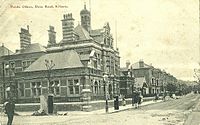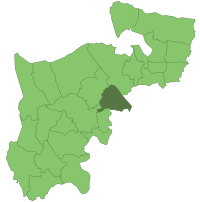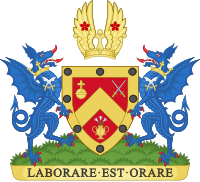Municipal Borough of Willesden facts for kids
| Willesden | |
| Motto: Labore est Orare (To Work is to Pray) | |
 Willesden Town Hall (demolished in 1972) |
|
 Willesden within Middlesex in 1961 |
|
| Geography | |
| Status | Local board (1874 - 1894) Urban district (1894 - 1933) Municipal borough (from 1933) |
| 1911 area | 4,384 acres (17.74 km2) |
| 1931 area | 4,385 acres (17.75 km2) |
| 1961 area | 4,633 acres (18.75 km2) |
| HQ | Dyne Road, Kilburn |
| History | |
| Created | 1874 |
| Abolished | 1965 |
| Succeeded by | London Borough of Brent |
Quick facts for kids Demography |
|
|---|---|
| 1911 population - 1911 density |
154,214 32/acre |
| 1931 population - 1931 density |
184,434 42/acre |
| 1961 population - 1961 density |
171,001 37/acre |
| Politics | |
| Governance | Willesden Urban District Council Willesden Borough Council |
 Coat of arms of the borough council |
|
Willesden was an important local government area in Middlesex, England. It existed from 1874 until 1965. Willesden was part of the big city area of London. It was located next to the County of London on its east and south sides.
Contents
History of Willesden
Willesden started as a local government district in 1874. This meant it had its own local council to manage things. In 1894, it became an urban district. Then, in 1933, it officially became a municipal borough. This gave it more powers and responsibilities.
In 1901, about 114,811 people lived in Willesden. The population grew to its highest point in 1931, with 184,434 residents. By 1961, the number of people had slightly dropped to 171,001. The area of Willesden was about 4,384 acres (17.74 square kilometers) in 1911. It grew a little to 4,633 acres (18.75 square kilometers) by 1961.
Willesden included several well-known areas. These were Kilburn, Harlesden, Neasden, Willesden itself, Cricklewood, Dollis Hill, and Brondesbury.
In 1965, the Willesden district was officially ended. Its area became part of Greater London. Willesden joined with the Borough of Wembley. Together, they formed the new London Borough of Brent.
The main offices for Willesden's local government were built in 1891. They were located on Dyne Road in Kilburn. These offices were later made bigger and became known as Willesden Town Hall. After Willesden joined Brent, the new council moved its main offices to Wembley. Willesden Town Hall was then taken down in 1972.
Local Politics in Willesden
At first, elections for the urban district council were not about political parties. This changed around 1910. That year, a group called the Moderates won most of the seats. They were generally in favor of the Conservative Party. The Progressive and Labour councillors formed the opposition.
By 1921, the Labour Party started to gain more influence. This led to a new group forming called the Ratepayers Association. This group was against Labour. The Ratepayers Association held power until 1933. From 1933 until Willesden was abolished in 1965, the Labour Party controlled the borough council almost every year.
Willesden's Coat of Arms
When Willesden became a borough in 1933, it was given its own special coat of arms. A coat of arms is a unique design that represents a place or family. Willesden's motto was in Latin: Labore est Orare. This means To Work is to Pray.
The symbols on the shield of the coat of arms told stories about Willesden's history:
- An orb (a ball with a cross on top) came from the arms of King Athelstan. He gave land in Neasden-cum-Willeseden to a monastery long ago. This is one of the earliest records of the area.
- Two crossed swords came from the arms of the Diocese of London. This showed that St Paul's Cathedral owned land in Willesden during the time of the Domesday Book.
- A pot of lilies was a symbol for St Mary. She is the patron saint of the old parish of Willesden.
- The border around the shield had eight black circles. Each circle represented one of the eight manors (large estates) that Willesden was divided into a long time ago.
Above the shield was a crest. It had two wings from the arms of Richard Bancroft. He was an Archbishop of Canterbury who owned land in Mapesbury. The wings had red five-leaf shapes on them. These shapes came from the arms of All Souls College, Oxford. This college also owned a lot of land in the Willesden area.
The coat of arms also had two supporters, which were two blue dragons. Around their necks, they wore gold Saxon crowns. On their shoulders, they had crossed seaxes, which are a type of notched sword. These symbols came from the arms of the Middlesex County Council.
When the London Borough of Brent was formed in 1965, many of these symbols from Willesden's coat of arms were included in Brent's new design.
Affiliated Military Regiment
In 1951, the Willesden Borough Council adopted a military unit. This unit was the 484 Heavy Anti-Aircraft Regiment, Royal Artillery. It was a Territorial Army unit, which means it was made up of part-time soldiers. The regiment was based in Willesden. It had originally been formed in 1938 from people who worked for the London Passenger Transport Board. The regiment was eventually disbanded in 1955.
Images for kids


